Demining
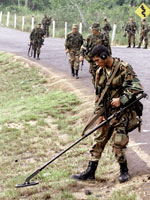
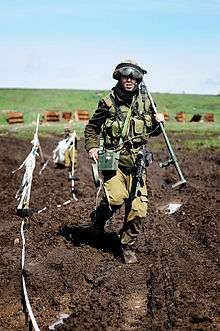
Demining or mine clearance is the process of removing land mines from an area, while minesweeping describes the act of detecting mines. There are two distinct types of mine detection and removal: military and humanitarian.
Minesweepers use many tools in order to accomplish their task. Tools have historically included many trained animals, including dogs and rats, but most often in the modern world minesweepers rely on metal detectors or vehicles with a wide variety of mechanical tools attached to them. There also are or have been other methods developed to detect mines, including the use of trained marine mammals, bacteria, acoustics, and other more exotic methods.
Military mine clearance
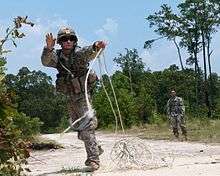
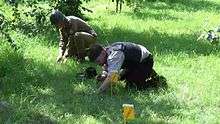
In the combat zone, the process is referred to as mine clearance. According to the doctrine of the U.S. and other armies, mine clearance is carried out by combat engineers.
The military priority is to breach the minefield quickly in order to create a safe path for troops or ships. Speed is vital, both for tactical reasons and because units attempting to breach the minefield may be under enemy fire. Both anti-personnel mines and anti-tank mines must be removed, although only in the lanes through which troops or vehicles are planned to advance.
The risk to sappers is far greater because they may be called upon to perform clearance as tactics dictate, including in all-weather conditions and on schedule. Command may accept casualties in the process. Furthermore, it is accepted that mine clearance will be imperfect and there may be casualties from undiscovered mines. One advantage is that, in military operations, sappers are dealing with recently laid mines that respond predictably to clearance, have not 'migrated', and have not degraded (unless old stock was used). In this they are often aided by technical intelligence on the current adversary's mines, which are usually of a single type.
In these mine clearance operations, the methods that are applied for detection and removal are quicker, but less exacting. These methods include those that detect and remove in a single action, such as mechanical demining, carpet bombing, burning of the land or the use of Bangalore torpedoes or mine-clearing line charges.
Humanitarian demining
In times of relative peace, the process of mine removal is referred to as demining. This is a thorough, time-intensive process that seeks to locate all mines so that the land or sea area may be safely returned to normal use. It is vital that this process be exhaustive. Even if only a small handful of mines remain undiscovered, incomplete demining can actually lead to an increase in civilian mine casualties as local people re-occupy an area they previously avoided in the belief that it has been made safe. In this context demining is one of the tools of mine action. Coordinated by Mine Action Coordination Centers run by the United Nations or a host government, civilian mine clearance agencies are tasked with the demining. In post-conflict areas, minefields are often contaminated with a mixture of explosive remnants of war (ERW) that includes unexploded ordnance as well as landmines. In that context, the humanitarian clearance effort is often referred to as battle area clearance.
In some situations, clearing landmines is a necessary condition before other humanitarian programs can be implemented.[1] A large-scale international effort has been made to test and evaluate existing and new technologies for humanitarian demining, notably by the EU, US, Canadian and Japanese governments and by the Mine Action Centres of affected countries.[2][3]
Current humanitarian demining methods
The main methods used for humanitarian demining on land are: manual detection using metal detectors and prodders, detection by specially trained mine detection dogs, and mechanical clearance using armored vehicles fitted with flails, tiller or similar devices. There is an organization, APOPO, that is training African rats to detect landmines much as dogs do, offering a local solution to countries in Africa.[4] In many circumstances, the only method that meets the United Nations' requirements for effective humanitarian demining, the International Mine Action Standards (IMAS),[5] is manual detection and disarmament.[6] The process is typically slow, expensive and dangerous, although demining can be safer than construction work if procedures are followed rigorously.[7] New technologies may provide effective alternatives.
Manual detection with a metal detector

Metal detectors were first used, after their invention by the Polish officer Józef Kosacki.[8] Allies used his invention, known as the Polish mine detector, to clear the German mine fields during the Second Battle of El Alamein when 500 units were shipped to Field Marshal Montgomery.[9][10] The "Polish" mine detector was later used together with the ERA mine-locator for detecting beach mines.[11]
The first step in manual demining is to scan the area with metal detectors,[12] which are sensitive enough to pick up most mines but which also yield about one thousand false positives for every mine.[6] Some mines, referred to as minimum metal mines, are constructed with as little metal as possible - as little as 1 gram (0.035 oz) - to make them difficult to detect. Mines with no metal at all have been produced, but are rare. Areas where metal is detected are carefully probed to determine if a mine is present; the probing must continue until the object that set off the metal detector is found.
Dogs
Well-trained dogs can sniff out explosive chemicals like TNT in landmines, and are used in several countries.[13]
Rats
Like dogs, giant pouched rats are being trained to sniff out chemicals like TNT in landmines.[14] These rats are currently working in minefields in Mozambique and are trained in Tanzania by APOPO.[15] The rats are called HeroRATS.
These animals also have the advantage of being far lower mass than the typical human. They are less likely to set off small mines intended to injure or kill people, if the bomb-sniffing animal crosses directly over the top of a buried mine.
Mechanical clearance
Special machines effectively combine mine detection and removal into one operation. In the past, these machines were applied in both mine clearance and demining but are now generally used only for demining. They can be used to verify land that is not expected to be contaminated or as an extra layer of security after an area has been cleared by another method, such as dogs.
The machines consist of a special vehicle that is driven through the minefield, deliberately detonating the mines it drives over. These vehicles are designed to withstand the explosions with little damage. Some are operated directly with armour to protect the driver; some are operated under remote control.
- Mine rollers and mine flails. The roller method originated during World War I and the flail method during World War II but both are still used. Neither system is completely reliable and both will leave undetonated mines, requiring the minefield to be rechecked by another method. Mine flail effectiveness can approach 100% in ideal conditions, but clearance rates as low as 50–60% have been reported.[16] This is well below the 99.6% standard set by the United Nations for humanitarian demining.[6]
- Mine plow - a device in front of a tank that excavates the ground, exposing any mines or turning them upside down, which significantly lessens their effects if they explode.
- The two of the above are sometimes combined on the same vehicle.
- Modified long-armed demining bulldozers are being used in a number of countries. They have the capability to remove vegetation before demining and can withstand antipersonnel and antitank landmines. Their long arms provide the benefit of reducing damage to the main body, especially to the operator's cab. Three inch (7.62 cm) thick bulletproof glass protects the operator from directional mines.[17][18]
Recently, armies have developed armored demining vehicles, and specially armored bulldozers, that are remote controlled. This eliminates risk to the operator. Notable examples are the Caterpillar D7 MCAP (United States) and Raam HaShachar Caterpillar D9N (Israel).
- Mechanical clearing equipment
 World War II Sherman Crab mine-flail tank under test, April 27, 1944.
World War II Sherman Crab mine-flail tank under test, April 27, 1944.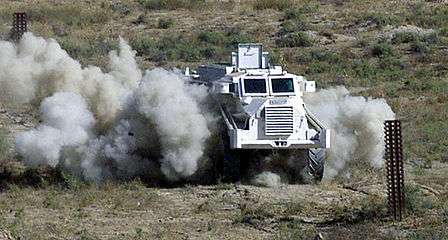
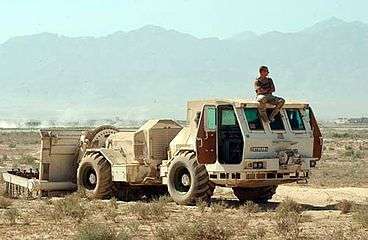 Hydrema mine clearing vehicle.
Hydrema mine clearing vehicle. IDF Caterpillar D9 armored bulldozer - used with the standard blade or a special mineplow for demining and removal of IEDs
IDF Caterpillar D9 armored bulldozer - used with the standard blade or a special mineplow for demining and removal of IEDs
Personal protective equipment

Deminers may be issued personal protective equipment (PPE) such as helmets, visors, armoured gloves, vests and boots, in an attempt to protect them if a mine is set off by accident. IMAS specifies standards for such equipment but draws attention to its limitations and states that at close quarters, antipersonnel fragmentation mines and antitank mines overmatch PPE currently available.[5] PPE can afford significant protection against antipersonnel blast mines, and these are more common. Related technologies that have been developed to improve safety include large, pillow-like pads strapped to the bottoms of shoes that distribute weight and dull the impact of footsteps, as very slight disturbances of the ground can tip off old, unstable, or intentionally sensitive mine triggers. First developed in 1954 by the British as over shoes that are first inflated by the combat soldier, this specialized footwear has become a needed item for some demining operations.[19]
Removal methods
Removal methods in demining
In demining, once an object has been detected it is removed by one of the following methods:
- Manual disarmament.
- Remote burning of the explosive. Where possible, it is better to burn the explosive without detonation. Diethylene triamine (a close relative of ethylenediamine) reacts with TNT to generate heat. The compound that results from this reaction can then be combusted without detonation.[20] It has been reported that this amine is hypergolic with TNT, Tetryl, Composition B and other TNT based explosives, but it does not react in the same way with RDX or PETN-based explosives. Other nitrogen-containing organic ligands (e.g. pyridine, diethylamine and pyrole) are known to be hypergolic with TNT.[21]
- Setting the mine on fire while avoiding high-order detonation. This can be done by cutting holes in the mine without detonating its contents.[22]
Removal methods in mine clearance
Some removal methods that are not applied in humanitarian demining, but are common in mine clearance, include:
- The Bangalore Torpedo of World War II — the predecessor to the mine-clearing line charge that clears a path through a minefield. This can also be done using the Antipersonnel Obstacle Breaching System or Giant Viper, a hose-pipe filled with explosives and carried across a minefield by a rocket.[23]
- Helicopters dragging a plow to overturn or detonate mines. This has the problem of bringing down the helicopter when the plow snags onto objects such as large rocks, but has been corrected by use of pressure-sensitive plow rakes which release when over-pressured. This does, however, affect its effectiveness as mines planted in hard ground or near rocks will not be detonated.
- Cattle and other heavy livestock are often left to graze in mined areas in order to facilitate mine detonation.
- The Nazi Germans used captured civilians who were chased across minefields to detonate the explosives. According to Laurence Rees, "Curt von Gottberg, the SS-Obergruppenfuhrer who, during 1943, conducted another huge anti-partisan action called Operation Kottbus on the eastern border of Belorussia, reported that 'approximately two to three thousand local people were blown up in the clearing of the minefields'."[24]
Case study
Along the China-Vietnam border are numerous minefields. These are the legacy of border clashes in the 1980s. The mines are mainly anti-personnel, and have kept large areas of arable land from use by local farmers. A typical demining process deployed by the Chinese is as follows. Firebreaks are dug around the minefield to be cleared. Then engineers would set the minefield on fire with flamethrowers. Key factors of this burning process are: thick vegetation covering the minefields; most anti-personnel mines are buried very close to the ground level; the mines are made of mostly either wood, thin metal or plastic. This burning process would usually destroy about 90% of the mines, as the mines are either detonated or melted. Mines which have trip wires would have these wires burned off. Demining teams then would plow the area with mine detectors. When the teams have cleared the mines, they would walk over the field hand in hand themselves to show to the locals that all the mines have been cleared.[25]
Detection methods under development
In 2003, the Rand Corporation published a comprehensive report on innovative methods of landmine detection.[26]
Advanced electromagnetic methods
Ground penetrating radar
Conventional metal detectors rely on electromagnetic signals with frequencies of the order of 10–100 kHz, which are not sensitive to plastic or wooden mine bodies and the high explosive block itself. The only part of a low-metal mine that they may be able to detect is the detonator. Much higher frequency signals (of the order of 1 GHz) are employed in Ground Penetrating Radar (GPR) and these signals are also sensitive to the non-metallic parts of the mine. Unfortunately, as they are also affected by innocuous objects such as tree roots and stones and by local changes in soil moisture, it is difficult to distinguish a mine on a GPR image.
Dual-sensor
A hybrid approach employing both GPR and metal detector sensors in a single instrument has been developed by several companies and research organisations.
Biological detection
Honey bees
Research by the University of Montana has revealed that honey bees can, with minimal training, be used to detect landmines with a far greater accuracy and far higher clearance rate than dogs or rats.[27]
Mammals
Recent experiments with the Gambian giant pouched rat, also known as the African giant pouched rat, have indicated that it has the required sensitivity to smell, can be trained reliably with food-reward incentives, and is typically too small to set off the mines.[28] These rats also offer a local solution to many African countries because they are indigenous to East Africa. These rats are trained by a non-profit, research organization called APOPO and are called HeroRATs. Additionally, experiments with electrode-guided rats suggest that demining could one day be accomplished by guiding "ratbots" into areas that humans are unable to reach.[29]
Engineer Thrishantha Nanayakkara and colleagues at the University of Moratuwa in Sri Lanka have come up with a method where a dwarf mongoose is trained to detect landmines by smell and guided by a remote-controlled robot.[30][31]
The U.S. Navy Marine Mammal Program uses sea lions and dolphins, among other species, in the detection of seamines.[32]
Plants
The mustard Arabidopsis thaliana, one of the best-studied plants in the world, normally turns red under harsh conditions. But using a combination of natural mutations and genetic manipulation, scientists from Danish biotechnology company Aresa Biodetection, created a strain that only changes color in response to the nitrous oxide that leaks from landmines and other explosives. Because nitrous oxide can also be formed by denitrifying bacteria, there is some risk of false positives using this technique, and researchers are attempting to make the plant less sensitive. The plants would aid demining by indicating the presence of mines through color change, and could either be sown from aircraft or by people walking through demined corridors in minefields. As of February 2005, no studies have been conducted with actual landmines, though successful studies have been done in greenhouses. In order to prevent the spread of this genetically modified organism into the wild, the plants have been further modified so that they will only sprout when provided with an external growth factor.[33]
Bacteria
A bacterium, known as a bioreporter, has been genetically engineered to fluoresce under ultraviolet light in the presence of TNT. Tests involving spraying such bacteria over a simulated minefield successfully located mines. In the field, this method could allow for searching hundreds of acres in a few hours, which is much faster than other techniques, and could be used on a variety of terrain types. While there are some false positives (especially near plants and water drainage), even three ounces of TNT were detectable using these bacteria. Unfortunately, there is no strain of bacteria capable of detecting RDX, another common explosive, and the bacteria may not be visible under desert conditions. Also, well-constructed munitions that have not had time to corrode may be undetectable using this method.[34]
Nuclear detection
There are two principal techniques to detect land mines through nuclear reactions. Both rely on the use of neutrons.
The first such technique relies on the fact that the vast majority of explosives used in land mines are very nitrogen rich when compared with other materials. To detect such anomalies one may make use of the nuclear reaction
- 14(n, γ)15N (10.8 MeV)
In practice a detection system using this reaction works by subjecting the mine to thermal neutrons while searching for the characteristic gamma ray emitted from the excited state in nitrogen-15; these photons will only be observed when an object containing nitrogen is being subjected to the neutron irradiation.[35] One possible neutron source is californium-252 which undergoes spontaneous fission. A better neutron source is to use a sealed tube electrostatic D-T neutron generation tube, this has the advantage that the tritium is much less radiotoxic than the californium so in the event of an accident such as an explosion, the nuclear mine detection equipment would pose a smaller threat to humans. This type of explosive detection has been proposed for use in airport security and for the detection of explosives in trucks coming into military bases.[36][37][38]
An alternative way of spotting land mines through nuclear reactions with the help of neutrons is that of measuring the thermalization of neutrons. In this technique the soil is irradiated by fast neutrons and the flux of thermal neutrons scattering back is measured. The motivation for this technique is that explosives contain much higher concentrations of hydrogen, which is a very effective moderator of neutrons.[39]
Acoustic detection
It is possible to detect land mines by directing sound waves at the area to be demined, which causes the land mines to vibrate, and then using a laser to search for vibrations on the surface by means of the Doppler shift - this technique is termed scanning laser doppler vibrometry. Such devices have been constructed, e.g., at the University of Mississippi,[40] at MIT[41] and by the Kayser-Threde Company.[42]
See also
References
- ↑ 'Landmines - Some Common Myths" Demining Research website. University of Western Australia, updated January, 2000.
- ↑ "International Test and Evaluation Program for Humanitarian Demining (ITEP)". Itep.ws. Retrieved September 10, 2009.
- ↑ "Serac Unit - :Metal detector Trials". Serac.jrc.it. Archived from the original on June 4, 2009. Retrieved September 10, 2009.
- ↑ "A P O P O". A P O P O. Archived from the original on August 2, 2008. Retrieved September 10, 2009.
- 1 2 "International Mine Action Standards (IMAS) project". Gichd.ch. Archived from the original on December 12, 2006. Retrieved September 10, 2009.
- 1 2 3 "What Is Demining?" Demining Research website. University of Western Australia, updated September 22, 1998.
- ↑ "What you can do to help" Demining Research website. University of Western Australia, updated January, 2000.
- ↑ The History of Landmines by Mike Croll published in Great Britain in 1998 by Leo Cooper, Pen & Sword Books Ltd. ISBN 0-85052-628-0
- ↑ "The Polish Contribution to The Ultimate Allied Victory in The Second World War" Tadeusz Modelski, Worthing, England 1986, Page 221
- ↑ Popular Science, May 1943, Detector Spots Buried Mines
- ↑ The Royal Engineers Journal 1962-76 p34 "One man uses the early "Polish" mine-detector whilst others use the ERA mine-locator."
- ↑ "Metal detector handbook for humanitarian demining" (PDF). Archived from the original (PDF) on March 3, 2014. Retrieved November 8, 2013.
- ↑ "Mine Detection Dogs in Use". Demining Research website. University of Western Australia, updated March 28, 2000.
- ↑ "APOPO". APOPO. Retrieved September 10, 2009.
- ↑ "ReliefWeb » Vacancy » Management of APOPO Mine Action Operations". Reliefweb.int. July 31, 2008. Retrieved September 10, 2009.
- ↑ "A Study of Mechanical Application in Demining" (PDF). Geneva International Centre for Humanitarian Demining. 2004. Retrieved July 23, 2007.
- ↑ "Hitachi Now: The Challenge of Demining (Part 1) Returning fertility to the land and putting a smile on the face of the children". Film.hitachi.jp. Retrieved September 10, 2009.
- ↑ "Japanese Contraption Safely Removes Landmines". Gizmodo.com. March 30, 2004. Retrieved September 10, 2009.
- ↑ "Inflatable Sneakers for Mine Field Distributes Weight Safely." Popular Mechanics, November 1954, p. 106.
- ↑ Humanitarian-demining.org
- ↑ Humanitarian-demining.org
- ↑ "Electrochemical Machining for UXO Neutralisation". Mech.uwa.edu.au. Retrieved September 10, 2009.
- ↑ John Pike (January 25, 2006). "Mk7 Antipersonnel Obstacle Breaching Systems (APOBS)". Globalsecurity.org. Retrieved September 10, 2009.
- ↑ Laurence Rees (1999). War of the century: when Hitler fought Stalin. BBC Books. p.118. ISBN 0-563-38477-8
- ↑ "China , Landmine Monitor Report 2004". Icbl.org. Retrieved September 10, 2009.
- ↑ "Alternatives for Landmine Detection". Monograph/Reports. RAND. 2003. Retrieved September 10, 2009.
- ↑ "Bees used in Area Reduction and Mine Detection". Jerry J. Bromenshenk et al. Journal of Mine Action. Issue 7.3. December 2003.
- ↑ "Move Over Sniffer Dogs, Here Come Africa's Rats." Reuters, September 27, 2004.
- ↑ "Here Come the Ratbots". BBC News, May 1, 2002.
- ↑ "Mongoose-robot duo sniff out landmines". Technology.newscientist.com. April 26, 2008. Retrieved September 10, 2009.
- ↑ "A Human-Animal-Robot Cooperative System for Anti-Personal Mine Detection" (PDF). Archived from the original (PDF) on March 27, 2009. Retrieved September 10, 2009.
- ↑ "Mine Hunting Systems of the U.S. Navy Marine Mammal Program". Spawar.navy.mil. Retrieved September 10, 2009.
- ↑ Mine-sniffing Plants. American Communications Foundation, February 17, 2005. Archived January 5, 2006, at the Wayback Machine.
- ↑ R.S. Burlage, M. Hunt, J. DiBenedetto, and M. Maston. Bioreporter Bacteria For The Detection Of Unexploded Ordnance. Excerpt from the Demining Research website.
- ↑ IAEA.org
- ↑ Aydin Karahan, "Drug and Explosive Detection"
- ↑ NDM Article - Fast Neutron Technology Used for Explosive Detection Archived October 8, 2006, at the Wayback Machine.
- ↑ Batch.ac.uk
- ↑ 356 IEEE TRANSACTIONS ON NUCLEAR SCIENCE, VOL. 53, NO. 1, FEBRUARY 2006 Land Mine Detection With Neutron Back Scattering Imaging Using a Neutron Generator http://ieeexplore.ieee.org/stamp/stamp.jsp?arnumber=01611003
- ↑ "Laser Doppler Vibrometer-Based Acoustic Landmine Detection Using the Fast M-Sequence Transform, N Xiang and J M Sabatier, IEEE Geosci. and Remote Sens. Letts. Vol. 1 (4) 2004" (PDF).
- ↑ "Vibrations could reveal landmine locations". New Scientist. December 22, 2006. Retrieved December 29, 2006.
- ↑ "M Heybel, K-H Bers and V H Klein, Proc. SPIE, Volume 5415, pp. 80-90 (2004)". Archived from the original on 2007-06-24.
External links
| Look up demining in Wiktionary, the free dictionary. |
|